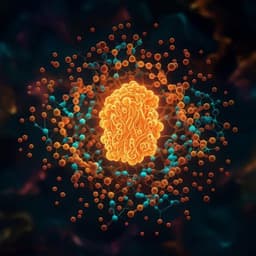
Medicine and Health
The cryo-EM structure of the bd oxidase from *M. tuberculosis* reveals a unique structural framework and enables rational drug design to combat TB
S. Safarian, H. K. Opel-reading, et al.
Explore groundbreaking research from Schara Safarian and colleagues that unveils the cryo-EM structure of cytochrome bd oxidase from Mycobacterium tuberculosis. This study reveals a novel MK-9-binding site and a unique disulfide bond, paving the way for the development of targeted drugs to combat tuberculosis and reduce drug resistance.
~3 min • Beginner • English
Introduction
Tuberculosis remains a leading cause of global mortality from infectious diseases, exacerbated by the emergence of extensively drug-resistant strains and the long duration of current therapies. The mycobacterial respiratory chain is an attractive target space for novel antimycobacterial agents, as evidenced by the success of bedaquiline and the synthetic lethality observed when inhibiting multiple terminal oxidases. Cytochrome bd oxidase, a quinol-oxidizing terminal oxygen reductase encoded by the cydAB gene cluster, is critical for M. tuberculosis pathophysiology under low-oxygen conditions and contributes to tolerance against inhibitors of the alternative terminal oxidase branch. Deletion mutants show heightened susceptibility to inhibitors of the bc1:aa3 supercomplex, underscoring bd oxidase as a key therapeutic target. Prior structural information existed for bd oxidases from Geobacillus thermodenitrificans and Escherichia coli, revealing architectural conservation but mechanistic and accessory-subunit differences across taxa. However, lack of an atomic-resolution structure from M. tuberculosis hindered structure-guided drug design. This study addresses that gap by determining a 2.5 Å cryo-EM structure of the M. tuberculosis bd oxidase and probing its dynamics via atomistic MD, aiming to uncover unique structural features relevant to function and druggability.
Literature Review
Previous structural studies resolved bd oxidases from G. thermodenitrificans (3.8 Å, PDB 5DOQ) and E. coli (2.7–3.3 Å, PDB 6RKO, 6RX4), showing similar core architectures but notable differences in side-chain details, prosthetic group arrangements, and accessory subunits (e.g., CydX/CydH in proteobacteria). These differences suggest mechanistic diversity among homologs and highlight the need for the M. tuberculosis structure to inform species-specific inhibitor design. Functionally, cytochrome bd oxidase has been implicated in survival under oxidative and antibiotic stress, and in compensatory respiration when the bc1:aa3 branch is inhibited, supporting dual-inhibition strategies against M. tuberculosis.
Methodology
Expression and purification: The M. tuberculosis cydABDC operon was cloned into pYUB28b with a C-terminal FLAG tag on CydB and expressed in Mycobacterium smegmatis mc2 155 ΔcydAB. Cells were grown in LBT with hygromycin, lysed by high-pressure homogenization, and membranes isolated by ultracentrifugation. The bd oxidase was solubilized with 1% DDM and purified by anti-FLAG affinity chromatography followed by size exclusion chromatography.
Nanodisc reconstitution: Purified bd oxidase was reconstituted into POPC nanodiscs using MSP1D1 at a POPC:MSP1D1:bd ratio of 400:10:1, with detergent removal by Bio-Beads, and complexes separated by SEC. For inhibitor-bound structures, Aurachin D (500 µM) or AD3-11 (1 mM) was included throughout reconstitution.
Cryo-EM data collection and processing: Vitrified samples on glow-discharged Quantifoil grids were imaged on a Titan Krios G3i at 300 kV with a Gatan K3 detector (pixel size 0.837 Å), total dose ~108 e/Å2, defocus 1.1–2.1 µm. 12,070 movies were recorded. MotionCor2 and CTFFIND4 were used for motion and CTF correction; particles (~15 million picked by crYOLO) were processed in RELION-3.1 with classification, CTF refinement, Bayesian polishing, and focused strategies to yield a 2.5 Å map for the as-isolated mixed-valence state; additional inhibitor datasets reached 3.3 Å (Aurachin D) and 2.7 Å (AD3-11). Model building used E. coli bd-I (PDB 6RKO) as a guide in Coot with real-space refinement in Phenix and validation by MolProbity. Maps and model were deposited (EMD-12451, -12532, -12533; PDB 7NKZ).
Spectroscopy and functional assays: Redox difference UV–Vis spectra confirmed hemes b558, b595, and d. Oxygen consumption rates were measured in inverted membrane vesicles with NADH as substrate; titrations with Aurachin D gave IC50 values.
Mass spectrometry: Co-purified quinone species were identified by LC-MS (Shimadzu LCMS-9030), confirming oxidized menaquinone-9 (MK-9) adducts.
Computational analyses: Atomistic MD simulations were performed with the CHARMM36m force field on a POPC bilayer-embedded bd oxidase with 150 mM NaCl and TIP3P water using GROMACS 2019.6. Systems underwent minimization, NVT/NPT equilibration, and production runs (unconstrained). Simulations probed hydration, proton/water channels, Q-loop disulfide states, and MK-9 binding dynamics in oxidized and reduced forms (2 × 750 ns for each condition). Tunnel and cavity analyses used MOLE 2.5; structural comparisons used DALI; sequence conservation analyses employed Clustal Omega and taxonomy tools.
Key Findings
- Determined a 2.5 Å cryo-EM structure of the M. tuberculosis cytochrome bd oxidase reconstituted in POPC nanodiscs, revealing a CydA/CydB heterodimer with nine TM helices each and the canonical triangular arrangement of hemes b558, b595, and d in CydA.
- The non-catalytic CydB subunit lacks the ubiquinone (UQ-8) cavity seen in E. coli; instead, a cluster of Trp/Phe residues stabilizes TM helices 3, 4, 5, and 8 via van der Waals contacts, obviating a structural quinone. This stabilizing network is absent in G. thermodenitrificans, consistent with higher B-factors in that structure.
- Solvent and proton pathways: MD revealed a major cytoplasmic water-filled cavity (~20 Å at the CydAB interface) narrowing to a ~4 Å channel between TMH2/3 of both subunits, with a hydrogen-bond network (Asp59.B, Glu106.A, Ser107.A, Ser139.A, Glu62.B) leading toward the oxygen reduction site, suggesting a substrate proton pathway. A periplasmic water entry between TMHs 5 and 6 leads toward heme b595. A string of waters (~12 Å) connects heme b558 propionates to Glu396.A, potentially acting as a dielectric well for charge compensation.
- Q-loop architecture: The N-terminal QN segment (Pro256.A–Val309.A) contains Qh1 and Qh2 helices; the C-terminal QC segment (Thr310.A–Asn333.A) forms a horizontal helix (Qh3) that interacts with periplasmic loop 8 (PL8). A hydrophobic/aromatic cluster (Tyr321.A, Phe325.A, Tyr330.A with Pro401.A, Trp402.A, Pro406.A of PL8) and multiple hydrogen bonds rigidify this interface. Residues Phe325.A and Tyr330.A, known to be functionally important, likely stabilize Qh3–PL8 rather than directly bind substrate.
- Unique disulfide in QN: A disulfide bond between Cys266.A and Cys285.A rigidifies the QN region and reduces flexibility near Qh1. In contrast, the E. coli QN lacks this disulfide and remains flexible even with bound inhibitors, consistent with transient substrate binding at QN in proteobacteria.
- Quinol-like inhibitors did not bind at QN: Cryo-EM datasets with Aurachin D and AD3-11 (50–100-fold molar excess) showed no density at the canonical QN inhibitor site. MD showed both oxidized and reduced MK-9 fail to form specific interactions at QN and migrate into the membrane, suggesting the confined QN conformation in M. tuberculosis sterically hinders substrate access to Glu263.A near heme b558.
- Discovery of an allosteric MK-9 binding site: A previously unknown MK-9 site was identified in a cleft between TMH1 and TMH9 in proximity to heme b595; LC-MS confirmed co-purified oxidized MK-9. The pocket is formed by Trp9.A and Arg8.A of TMH1, Met397.A of TMH9, and the heme b595 porphyrin surface. Trp9.A stacks with the MK-9 naphthoquinone headgroup, shielding it from the membrane.
- MK-9 binding dynamics (MD, 2 × 750 ns per redox state): Oxidized MK-9 remained bound via π–π interactions with Trp9.A or heme b595 and intermittently formed H-bonds with Arg8.A/Trp9.A for 10–25% of the simulation time. Reduced MK-9 was more dynamic, maintaining interaction with Trp9.A but sampling alternate positions; it formed intermittent H-bonds with the heme b595 propionate (~20% of time) or with Ser340.A (~15%) after flipping toward TMH8.
- Sequence conservation supports co-evolution: Among 561 CydA sequences, 94 (16.8%) had a conserved Trp at the TMH1 position (over half from Actinobacteria). Only 30 orthologs (5.7%), all Actinobacteria, harbored both cysteines for the Q-loop disulfide; these also possessed the Trp9.A signature, implying correlated evolution of the disulfide-confined Q-loop and the MK-9 site.
- Functional assay: Oxygen consumption in inverted membranes showed potent inhibition by Aurachin D with an IC50 of 0.158 µM for bd oxidase–dependent respiration (with bc1:aa3 activity suppressed), indicating tractable pharmacology.
- Proposed electron transfer route: The MK-9 site near heme b595 may function as an alternative quinol oxidation domain, enabling electron transfer directly to heme b595 and potentially bypassing heme b558 when the QN is in a confined, inactive conformation.
Discussion
The structure reveals two defining features of the M. tuberculosis bd oxidase: a disulfide-stabilized QN loop and a dedicated MK-9 pocket near heme b595. Together, these features rationalize how M. tuberculosis maintains respiration under conditions where the canonical QN site is conformationally restricted. The MK-9 pocket provides a plausible alternative quinol oxidation/entry point for electron transfer directly to heme b595, consistent with MD-observed stable binding of oxidized MK-9 and transient, redox-dependent interactions in the reduced state. The rigidified Q-loop likely diminishes the transient binding dynamics typical of proteobacterial QN sites, explaining the absence of inhibitor density at QN despite high ligand excess.
These insights address the central question of species-specific bd oxidase architecture and mechanism, explaining prior genetic and pharmacological observations of bd oxidase importance in M. tuberculosis pathophysiology and its synergy with bc1:aa3 inhibition. The work provides actionable targets for rational drug design: (i) the Qc–PL8 interaction interface essential for stabilizing the periplasmic architecture, (ii) the membrane-embedded entry of the O-channel to block oxygen access, and (iii) the newly identified MK-9 site, which is enriched in Actinobacteria and thus offers specificity. The sequence conservation analysis supports a co-evolutionary link between the Q-loop disulfide and the Trp-lined MK-9 pocket, suggesting a broader relevance across pathogenic Actinobacteria.
Conclusion
This study delivers a 2.5 Å cryo-EM structure of the M. tuberculosis cytochrome bd oxidase and, combined with atomistic MD simulations, uncovers a unique, Actinobacteria-enriched structural framework: a disulfide-confined QN loop and an allosteric MK-9 binding pocket adjacent to heme b595. These features likely enable an alternative electron entry route and explain the divergence from proteobacterial mechanisms. The structure-function insights establish a robust foundation for rational, species-selective inhibitor design targeting (i) the Qc–PL8 interface, (ii) the O-channel entry, and (iii) the MK-9 pocket.
Future research directions include: elucidating the redox regulation and potential switching of the Q-loop disulfide in vivo; resolving structures of the enzyme in different redox and ligand-bound states (including bound native menaquinol and designed inhibitors); validating the proposed electron transfer pathway experimentally; and developing and testing inhibitors that exploit the MK-9 site and O-channel in cellular and animal models.
Limitations
- The as-isolated structure captures a mixed-valence state; additional redox and substrate-bound states may reveal further conformational dynamics, especially at the Q-loop.
- Despite high inhibitor excess, no density was observed at the canonical QN site; while consistent with a confined QN, transient or low-occupancy binding cannot be completely excluded by cryo-EM.
- MD simulations were performed in a POPC bilayer and at specific force-field settings; while extensive (2 × 750 ns), these conditions may not fully recapitulate the native mycobacterial membrane composition.
- The mechanistic role of the MK-9 pocket in catalysis remains inferential; direct biochemical and kinetic validation is needed to confirm electron transfer via this site.
- Small accessory subunits of unknown sequence cannot be entirely ruled out, though none were detected; generalization to all Actinobacteria requires further structural and functional studies.
Related Publications
Explore these studies to deepen your understanding of the subject.







